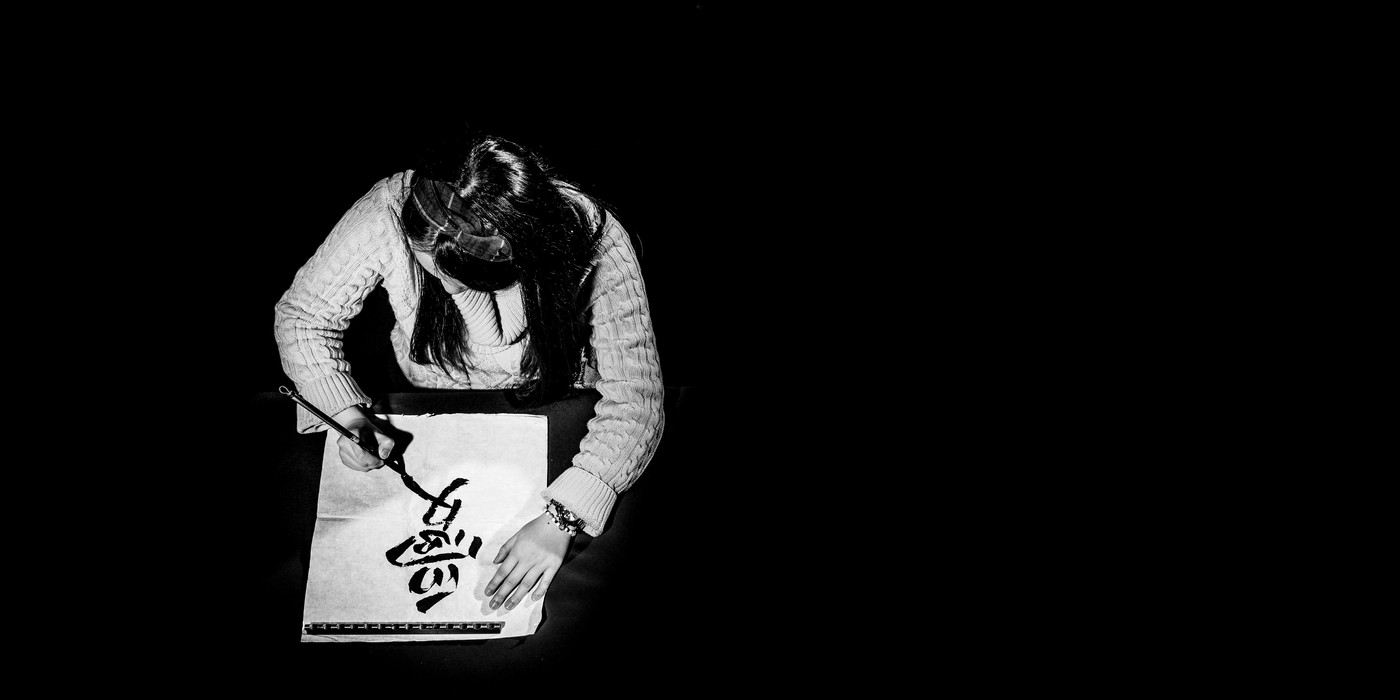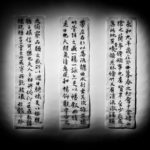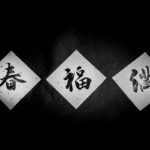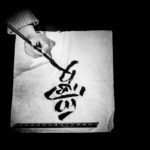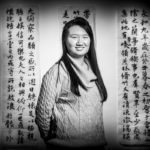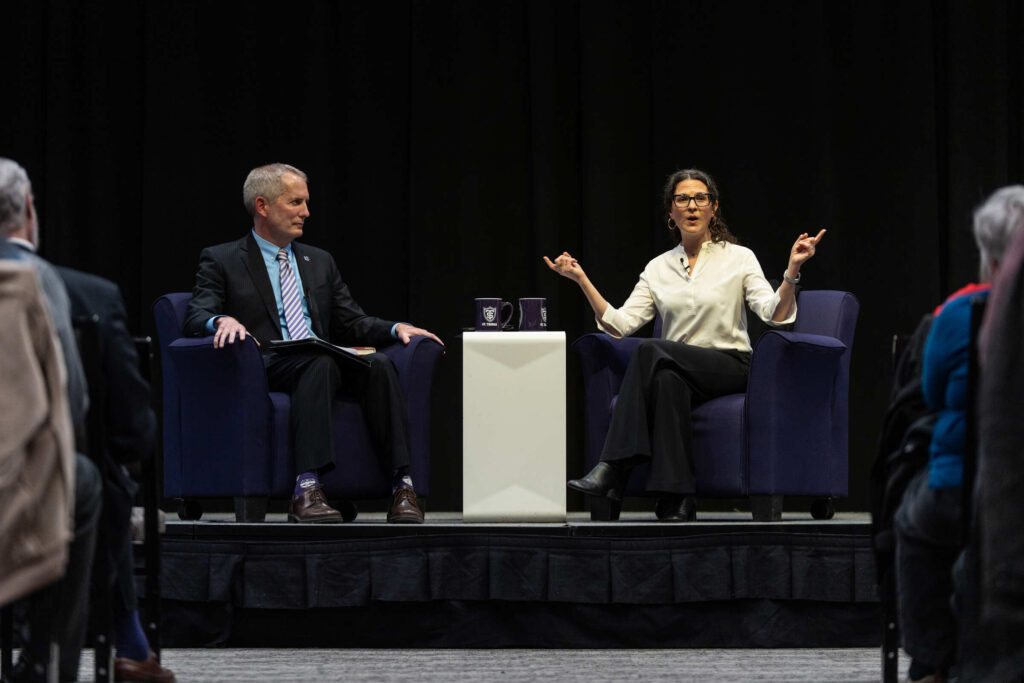Tina Wu dips her soft writing brush into a plastic cup filled with black ink and makes three short horizontal strokes and two curved vertical lines, followed by shorter vertical lines and a couple of squiggly ones. "This is ‘spring,’" she said, with a warm, contagious smile. "You hang it upside down if you want to encourage spring to come."
Wu is practicing Chinese calligraphy, an important treasure of her heritage. An international business major from New Tapei City, Taiwan, she spent her junior year at St. Thomas through an exchange program with her home campus, Tamkang University.
Carrying on her mother’s love of Chinese calligraphy, Wu took an early interest in it and has continued to practice and hone her skill.
Although she had been studying on campus for five months, only a couple of her American friends knew that she was a Chinese calligrapher. Her hidden talent came to light when she gave gifts to her local friendship family to celebrate the Chinese New Year in late January.
"It was beautiful," said Kjersti Duncan, part of Wu’s friendship family. "She presented our family with banners for the Chinese New Year and hung them on either side of our door." The delicate red paper couplets – a pair of poetry lines – welcome guests with good wishes for the new year. Since this is the Chinese year of the horse, the characters depict a poem about a horse charging into the new year, its mane flowing, and digging at the snow to bring up spring.
Yun-Chen
Known as Tina in America, her name is Yun-Chen – chosen before she was born by her mother because of how it looked when done in calligraphy.
"Forty years ago calligraphy was popular and it was required for my parents in elementary and junior high," Wu said. "Now it’s just one semester in elementary school."
"Once I learned it, I enjoyed it," Wu said. "Same as with piano; my mom asked me to try it and now I love it."
She was hooked. She practiced calligraphy at her teacher’s home from fourth through eighth grade and has kept it up ever since.
"When I finish doing calligraphy, I feel complete," Wu said. "I can show my parents, especially my mom, and she says ‘That’s really good.’
"I really focus when I do calligraphy. I try to make everything perfect. If one character is not perfect, it ruins the whole piece. I throw it away. I practice each character on regular paper until I’m satisfied and then I move on to the next character. After practicing, I can do it quickly."
Wu learned the Zhiyong style of calligraphy, named after a monk known for his calligraphy during the Sui Dynasty (589-618 AD).
"In ancient times, calligraphy (brush painting) was used for communication," Wu said. "After the invention of pens, pencils and email, people didn’t use it; it evolved into an art form."
Chinese calligraphy is an art unique to Asian cultures. It involves the writing of characters, and each character is made up of a series of single brushstrokes. Depending on the concentration of ink, the type of paper and the flexibility of the brush, artists develop their own styles.
Written Chinese is not based on alphabet letters or syllables. Chinese characters are glyphs which may depict objects (pictographs) or abstract ideas (ideographs).
Eight strokes are used to create Chinese characters: horizontal, vertical, left-falling, right-falling, rising, dot, hook and turning. Certain rules apply, such as the order of horizontal and vertical strokes within a character, and characters are written from top to bottom.
Traditional Chinese is written in vertical columns and read from top to bottom; the first column is on the right side of the page, and the text runs toward the left. Chinese characters are not usually linked to one another, so they can be arranged vertically or horizontally. Chinese characters are arranged in vertical columns, read from top to bottom and right to left across the column.
In modern times, the Western layout of horizontal rows from left to right, read from the top of the page to the bottom, has become more popular in written Chinese.
The Whole American Experience
Wu is not shy; she likes to be around people.
"Taiwanese people are not as individualistic as people in the U.S.," Wu said. "In Taiwan, it’s more family oriented. We’re a team. We travel with friends. Here, people eat in the cafeteria by themselves, but I’d feel weird. It’s not bad here, just different."
When she wasn’t hanging out with her two other classmates from Taiwan – June and Hang-Fang – or her three roommates in Morrison Residence Hall, Wu enjoyed spending time with her friendship family, Kjersti and Brian Duncan and their 4-year-old son, Aspen, and infant daughter, March, who live near campus.
"Kjersti and Brian are so nice to me," Wu said. "I always wanted to have a brother or sister, and now I think I do!"
"She’s been such a joy to our family," Kjersti said. "She has a neat enthusiasm about her. You can tell she’s here to get the whole American experience. I don’t know anything she wouldn’t be willing to try. She even tried Norwegian food, like pickled herring!"
Wu has immersed herself enthusiastically in the family, often bringing June and Hang-Fang with her. They have participated in many activities, such as Aspen’s birthday party, preschool music program and playing at Choo Choo Bob’s train store.
"Trick or treating on Halloween was hilarious," Kjersti said. "We’re new to this neighborhood and I wondered what my neighbors thought when a 4-year-old boy and three very enthusiastic Taiwan college students came to their door."
"I didn’t have time to make a costume," Wu said. "So I wore bunny ears, June was a cat and Hang-Fang was a minion from the movie ‘Despicable Me.’ The neighbors were so nice. They’d ask ‘Where are you from?’ and say ‘Welcome to Minnesota!’"
"We really enjoyed having Wu with us," Kjersti said. "When my daughter was born, we told my son ‘you have a sister’ and he asked ‘Is Tina my sister too?’ If we take in another student next year, she set the bar really high for our family."
Wu especially enjoyed participating in a Christmas gathering at which Brian played saxophone, Kjersti’s mom played piano, Aspen played tambourine and Wu sang. As part of the Women’s Choir at St. Thomas, she needed to practice carols for the upcoming Christmas concert, and was happy to join in.
"Music is my passion. I can’t live without it," Wu said.
She took voice lessons from Dede Jorsted at St. Thomas and sang in the Women’s Choir. Director Angela Mitchell appreciated Wu’s gusto: "Tina is full of joy and was always putting forth her best effort in choral rehearsals. When I gave instructions to the sopranos she was right with me, nodding in affirmation and sitting on the edge of her seat."
St. Thomas and Taiwan
Wu learned about the St. Thomas-Tamkang University exchange program from Dr. Michael F. Sullivan, who has been traveling to Taiwan to promote the program since it began in 2005. Sullivan, who was an associate professor of finance in the Opus College of Business and a former chief investment officer of the university, retired this spring.
"We were approached by Tamkang University to be one of their selected junior-year study abroad programs in their international business degree program," Sullivan said. "There are only six U.S. schools that are available to the Tamkang students."
Feedback from Taiwan students is that "they like our culture, attitude, program quality, and love our people," he said.
Wu, who speaks Mandarin Chinese with a Taiwan dialect, wanted to study where she could practice her English. As an international business major, she took accounting, marketing and management classes, along with English, communication and Introduction to Film, at St. Thomas.
"Tina is smart, friendly, warm and she worked really hard. She’s a stunning representative of every Taiwanese I have known," Sullivan said.
St. Thomas will host five students for the junior-year exchange program this fall. The program averages eight students a year.
St. Thomas and Tamkang had established an earlier alliance on a joint Masters of International Management degree. Sullivan taught an MIM course in international finance on his first trip to Taiwan in 2002. He estimated that more than 300 MIM graduates live in Taiwan.
Sullivan also received couplet banners from Wu during the Chinese New Year.
"Tina is so talented," Sullivan said. "This isn’t a card you throw away; it’s a piece of art."
In June, Wu returned to Taiwan.
"I don’t know what to do after graduation next year," she said. "I would really like to be a broadcaster, but my dad says business is a better major in Taiwan."
Her father is a retired computer engineer from Chunghwa Telecom, the biggest telecom company in Taiwan, and her mother is a retired pharmacist. Her grandparents own a hardware store, which proudly displays banners created by Wu.
Read more from St. Thomas magazine.
